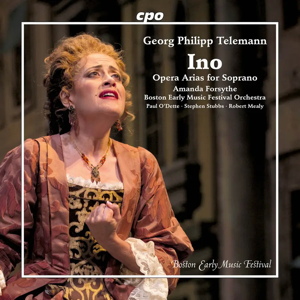
Georg Philipp Telemann (1681-1767)
Ino
Amanda Forsythe (soprano), Boston Early Music Festival Orchestra / Paul O’Dette and Stephen Stubbs
German and Italian texts included with English translations
rec. 2023, Sendesaal Bremen, Germany
cpo 555 658-2 [80]
Ino (1765) was one of Telemann’s last compositions and, as such, straddles the Baroque and Classical eras in music. In his liner notes, Steven Zohn makes the point that the composer appears purposefully to have exemplified those, and the intermediate galant, styles in the three principal numbers of this dramatic cantata, as though reviewing the long period of time during which his career endured, and also looking ahead to the emerging Classical style which younger composers were evolving at that moment. In this vivid performance by Amanda Forsythe with the Boston Early Music Festival Orchestra under the direction of Paul O’Dette and Stephen Stubbs from the lutes, they chart that development with characteristic renditions of each aria. In the narrative Ino, as the sister of Semele with whom Jupiter had an illicit relationship and lovechild, battles against the continuing rage of the jealous Juno. Not satisfied with having seen Semele disappear in a puff of smoke (as Baroque fans will recall from Handel’s stage work) the queen of the gods seeks revenge against Ino by causing her husband Athamas to go mad, kill one of their sons, and now attempt to kill the other. The Cantata sees Ino escape both Athamas and Juno, when she is rescued with her son by nymphs, and are turned into immortal sea gods.
Although there is a febrile energy in the first aria ‘Ungöttliche Saturnia’, Forsythe utilises a coaxing, brittle quality, with almost seductive little ornaments in the middle section, as though she is trying to assuage the furious Juno. The following accompanied recitative is more declaimed and clipped with vociferous instrumental interjections, giving way to more vocal variety by Forsythe. That settles down to a more sustained, if slightly raw, timbre for the more galant aria ‘Meint ihr mich, ihr Nereiden?’ with Lombardic rhythms on the flutes lending the movement an attractive lilt, echoing the Gallic airiness of the Ouverture from one of Telemann’s many orchestral Suites, used here as a prelude to the almost contemporary Cantata. The concluding number is more solidly foursquare and heroic, and could come from one of Mozart’s early operas. This performance aptly realises the work’s facets in standing at an important turning point in musical history, but for a more consistently theatrical account with similar period instrument support, Barbara Schlick’s or Ana Maria Labin’s accounts are preferable.
The rest of the disc is taken up with extracts from four operas by Telemann, three of them composed during his years at Hamburg in 1720s. The number from Germanicus is one of several Italian arias which the composer inserted into this early German opera from 1704, for a revival in 1710. The wailing solo oboe and Forsythe’s plangent vocal line over it almost seem to blend at times, and the piece has all the expressivity of a Handel opera aria, with its searing Italianate suspensions. The two German arias from Emma und Eginhard are simpler syllabic settings, and are rightly delivered with unostentatious charm. The fluttering sopranino recorders employed in ‘Mischt, ihr muntern Nachtigallen’ from Flavius Bertaridus create an appropriate sylvan atmosphere, to which Forsythe responds with a mellifluous vocal texture and a more ornamented repeated section to mimic the referenced birds. The disc ends with a sprightly rendition of a brief aria from Damon.
Apart from a stimulating performance of Ino, this disc also serves as an attractive sampler of Telemann’s operatic output, an area of his work often overlooked in favour of his instrumental music.
Curtis Rogers
Buying this recording via a link below generates revenue for MWI, which helps the site remain free.



Contents
Suite in D major, TWV 55:23 (1763) – Ouverture
Cantata ‘Ino’, TWV 20:41(1765)
Germanicus, TWV 21:deest (1704/10) – ‘Rimembranza crudel’
Emma und Eginhard, TWV 21:25 (1728) – ‘Erscheine bald, du Irrstern meiner Sinnen’, ‘Je mehr, dass ich mich widersetze’
Flavius Bertaridus, TWV 21:27 (1729) – ‘Gemahl und Sohnes Angedenken’, ‘Mischt, ihr muntern Nachtigallen’, ‘Ach komm, und schwebe’
Fanfare in D major, TWV 50:44 (1763)
Der neumodische Liebhaber Damon, TWV 21:8 (1724) – ‘Lache nur, du Tigerherze!’

















